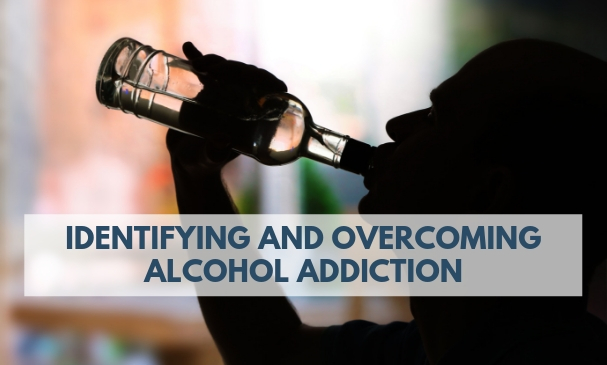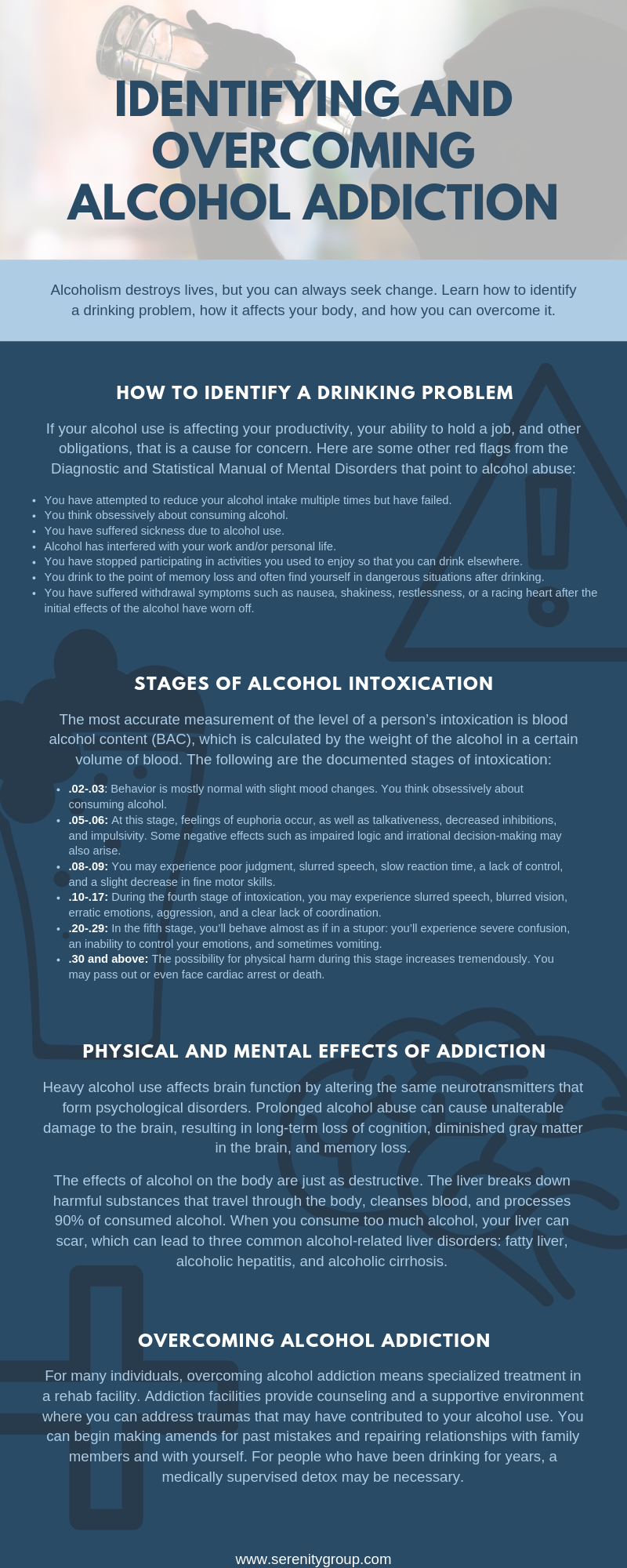Identifying and Overcoming Alcohol Addiction

Alcohol is a vital social component of American life, but some people unfortunately become addicted to the intoxicating drug. No one is impervious to alcohol’s effects, and the younger you begin drinking, the more likely you are to develop a destructive habit. In fact, according to AAA, “people who begin drinking before they’re 15 years old are five times more likely to be alcoholics later in life.”
Alcoholism destroys lives, but you can always seek change. Learn how to identify a drinking problem, how it affects your body, and how you can overcome it.
How to Identify a Drinking Problem
Identifying an alcohol use disorder is tricky, mainly because it doesn’t have a strict definition. In the words of Anne Fernandez, a clinical psychologist at the University of Michigan Treatment Services, “There’s no quantity or frequency of alcohol included in the definition. Essentially, it’s really about certain features of alcohol use becoming a problem in your life—you’re starting to lose control or not being able to cope without a drink.”
As Fernandez mentions, there will be outward signs that you’re developing a dependency on alcohol, including the neglect of relationships to people in your life and to your responsibilities. If your alcohol use is affecting your productivity, your ability to hold a job, and other obligations, that is a cause for concern. Here are some other red flags from the Diagnostic and Statistical Manual of Mental Disorders that point to alcohol abuse:
- You have attempted to reduce your alcohol intake multiple times but have failed.
- You think obsessively about consuming alcohol.
- You have suffered sickness due to alcohol use.
- Alcohol has interfered with your work and/or personal life.
- You have stopped participating in activities you used to enjoy so that you can drink elsewhere.
- You drink to the point of memory loss and often find yourself in dangerous situations after drinking.
- You have suffered withdrawal symptoms such as nausea, shakiness, restlessness, or a racing heart after the initial effects of the alcohol have worn off.
Depending on how many of these criteria you have exhibited, the severity of your disorder may vary from mild to moderate to severe and life-threatening. Some alcohol abusers also drive while drunk, which can lead to severe social, legal, and monetary problems down the line, including thousands of dollars in fines and possible prison sentences.
Stages of Alcohol Intoxication
Intoxication occurs at different stages for different people. The most accurate measurement of the level of a person’s intoxication is blood alcohol content (BAC), which is calculated by the weight of the alcohol in a certain volume of blood. BAC can be measured by testing the blood, urine, saliva, or breath, and it increases according to how quickly alcohol is consumed. Many factors, including height, muscle mass, metabolism, and gender, can affect a BAC reading. For example, a larger person will have more water in their system to dilute the alcohol, meaning their BAC level will be lower than that of a smaller person who consumes the same amount of drinks.
In all 50 states, impairment is legally defined by a BAC limit of .08%. For reference, a BAC of .10% means that your blood contains one part alcohol for every 1,000 parts of blood. The following are the documented stages of intoxication, which may help you gauge how impaired you are and whether you should continue drinking:
- .02-.03: Behavior is mostly normal with slight mood changes.
- .05-.06: At this stage, feelings of euphoria occur, as well as talkativeness, decreased inhibitions, and impulsivity. Some negative effects such as impaired logic and irrational decision-making may also arise.
- .08-.09: You may experience poor judgment, slurred speech, slow reaction time, a lack of control, and a slight decrease in fine motor skills
- .10-.17: During the fourth stage of intoxication, you may experience slurred speech, blurred vision, erratic emotions, aggression, and a clear lack of coordination.
- .20-.29: In the fifth stage, you’ll behave almost as if in a stupor: you’ll experience severe confusion, an inability to control your emotions, and sometimes vomiting.
- .30 and above: The possibility for physical harm during this stage increases tremendously. You may pass out or even face cardiac arrest or death.
Physical and Mental Effects of Addiction
Alcoholism is often comorbid with other psychological disorders such as depression, schizophrenia, PTSD, and anxiety and personality disorders. Clinicians often have difficulty analyzing how psychological disorders and long-term alcohol abuse relate: according to the National Institute on Alcohol Abuse and Alcoholism, “Heavy drinking associated with alcoholism can coexist with, contribute to, or result from several different psychiatric syndromes.”
Heavy alcohol use affects brain function by altering the same neurotransmitters that form psychological disorders. Prolonged alcohol abuse can cause unalterable damage to the brain, resulting in long-term loss of cognition, diminished gray matter in the brain, memory loss, and even a dangerous, chronic illness called Wernicke-Korsakoff syndrome, which is caused by a lack of vitamin B1 (a common effect of prolonged alcohol use). Long-term use of alcohol also diminishes the overall mass in the brain’s neurons, leading to brain damage and resulting in learning difficulties, unstable moods, and an inability to control muscle movements.
The effects of alcohol on the body are just as destructive. The liver breaks down harmful substances that travel through the body, cleanses blood, and processes 90% of consumed alcohol. When you consume too much alcohol, your liver can scar, which can lead to three common alcohol-related liver disorders: fatty liver, alcoholic hepatitis, and alcoholic cirrhosis.
- Fatty liver: The buildup of fat in your liver inhibits your liver’s ability to purify toxins. Though the condition can be reversed with a reduction in alcohol use, it leads to death in many people because it has no symptoms and is only diagnosable via biopsy.
- Alcoholic hepatitis: This is caused by inflammation of the liver from drinking. Symptoms include jaundice of the skin and eyes, nausea and vomiting, abdominal tenderness, and fatigue. In severe cases of alcoholic hepatitis, the mortality rate can reach 50%.
- Alcoholic cirrhosis: Cirrhosis is the deadliest of these disorders. It replaces healthy liver tissue with scar tissue, disrupting blood flow and damaging liver function. Late-stage cirrhosis can only be treated with a liver transplant.
Overcoming Alcohol Addiction
For many individuals, overcoming alcohol addiction means specialized treatment in a rehab facility. Addiction facilities provide counseling and a supportive environment where you can address traumas that may have contributed to your alcohol use. You can begin making amends for past mistakes and repairing relationships with family members and with yourself. For people who have been drinking for years, a medically supervised detox may be necessary. Many rehab facilities also offer aftercare options such as group therapy and the popular 12-step program to help individuals maintain their sobriety.
Psychological disorders complicate treatment, but it’s not impossible to seek treatment for both conditions. Detoxing your body from alcohol will allow you to seek medication for your psychological issues, which may not have been possible before, considering alcohol often conflicts with prescription drugs.
For people who have found themselves subject to a DUI charge, don’t hesitate to call Serenity Group for SR22 insurance in Las Vegas. Addressing your wrongdoings and seeking treatment will enable you to get your driver’s license squared away and to begin a path toward responsibility.


Recent Comments